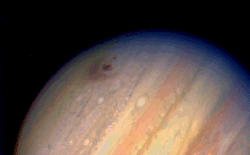
Hubble Space Telescope image of Comet Shoemaker-Levy 9, taken on May 17, 1994.
Comet Shoemaker-Levy 9 (SL9, formally designated D/1993 F2) was a comet that collided with Jupiter in 1994, providing the first direct observation of the collision of two solar system objects, not including collisions involving Earth. This generated a large amount of coverage in the popular media, and SL9 was closely observed by astronomers worldwide. The comet provided many revelations about Jupiter and its atmosphere and highlighted Jupiter's role in reducing space debris in the inner solar system.

The comet was discovered by astronomers Carolyn and Eugene M. Shoemaker and David Levy. Shoemaker-Levy 9 was located on the night of March 24, 1993, in a photograph taken with the 0.4-metre Schmidt telescope at the Mount Palomar Observatory in California. It was the first comet observed to be orbiting a planet rather than the Sun.


SL9 was in pieces ranging in size up to 2 kilometres in diameter, and is believed to have been pulled apart by Jupiter's tidal forces during a close encounter in July 1992. These fragments collided with Jupiter's southern hemisphere between July 16 and July 22, 1994, at a speed of approximately 60 kilometres per second. The prominent scars from the impacts could be seen on Jupiter for many months after the impact, and observers described them as more easily visible than the Great Red Spot.

One of the surprises of the impacts was the small amount of water revealed compared to prior predictions. Before the impact, models of Jupiter's atmosphere had indicated that the break-up of the largest fragments would occur at atmospheric pressures of anywhere from 300 kilopascals to a few megapascals (from three to a few tens bar), and most astronomers expected that the impacts would penetrate a hypothesised water-rich layer underneath the clouds.
Astronomers did not observe large amounts of water following the collisions, and later impact studies found that fragmentation and destruction of the cometary fragments in an 'airburst' probably occurred at much higher altitudes than previously expected, with even the largest fragments being destroyed when the pressure reached 250 kPa (2.5 bar), well above the expected depth of the water layer. The smaller fragments were probably destroyed before they even reached the cloud layer.
The visible scars from the impacts could be seen on Jupiter for many months after the impact. They were extremely prominent, and observers described them as more easily visible even than the Great Red Spot. A search of historical observations revealed that the spots were probably the most prominent transient features ever seen on the planet, and that while the Great Red Spot is notable for its striking colour, no spots of the size and darkness of those caused by the SL9 impacts have ever been recorded before.
Spectroscopic observers found that ammonia and carbon sulfide persisted in the atmosphere for at least fourteen months after the collisions, with a considerable amount of ammonia being present in the stratosphere as opposed to its normal location in the troposphere.
Counterintuitively, the atmospheric temperature dropped to normal levels much more quickly at the larger impact sites than at the smaller sites: at the larger impact sites, temperatures were elevated over a region 15,000–20,000 km wide, but dropped back to normal levels within a week of the impact. At smaller sites, temperatures 10 K higher than the surroundings persisted for almost two weeks. Global stratospheric temperatures rose immediately after the impacts, then fell to below pre-impact temperatures 2–3 weeks afterwards, before rising slowly to normal temperatures.
Hiç yorum yok:
Yorum Gönder